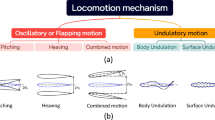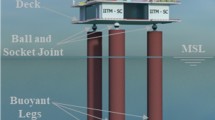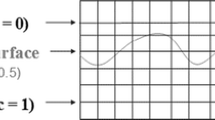Abstract
This paper reports an improved version of the numerical method used in a previous study on the dynamic simulation of purse seine gear in three dimensions. The improvement is achieved by refining the mass–spring model to take into account both the drag coefficient as a function of the attack angle and Reynolds number as applied to the setting operation of the purse seine gear. The validity of the numerical simulation is assessed by comparing the measured and calculated values for the sinking depth of the net. The numerical simulation is used to examine the sinking performance of the different designs in which large meshed-panels and netting materials are used together in the main body section of the netting. The results indicate that, compared to the prototype net, nets bearing larger mesh panels require more sinking depth with much more pronounced operational depth at corresponding times of the fishing operation when heavier netting material is used. Moreover, in the new net designs, lower tensile forces are exerted on both ends of the pure wire during pursing. The new net constructions with regard to the operational depth represent alternatives that may reduce the potential problem of frequent failed setting of the tuna purse seine gear.


















Similar content being viewed by others
References
Misund OA (1993) Avoidance behaviour of herring (Clupea harengus) and mackerel (Scomber scombrus) in purse seine capture situations. Fish Res 16:179–194
Beltestad AK (1981) Purse seines with hexagonal mesh. Southwest Fisheries Center Admin. Rep. (USA) LJ-81-12. NOAA/NMFS, La Jolla
Misund OA, Dickson W, Beltestad AK (1992) Optimization of purse seines by large-meshed sections and low lead weight. Theoretical considerations, sinking speed measurements and fishing trials. Fish Res 14:305–317
Machii T, Nose Y (1990) Mechanical properties of a rectangular purse seine in a special operation. Nippon Suisan Gakkaishi 56:557–562
Machii T, Nose Y (1992) Mechanical properties of a rectangular purse seine in ideal conditions. Fish Res 14:261–271
Kim SJ, Park JS (1998) Sinking resistance of purse seine—in the case of model purse seine with different d/l (in Korean with English abstract). Bull Korean Soc Fish Technol 34:274–282
Kim SJ (2004) An analysis of the sinking resistance of a purse seine. (2). In the case of a model purse seine with different netting material and sinker (in Korean with English abstract). Bull Korean Soc Fish Technol 40:29–36
Delmer TN, Stephens TC (1981) Development of a numerical simulation of purse seine fishing. Southwest Fisheries Center Admin. Rep. LJ-81 (13C). NOAA/NMFOS, La Jolla
Kim HY, Lee CW, Shin JK, Kim HS, Cha BJ, Lee GH (2007) Dynamics simulation of the behavior of purse seine gear and sea-trial verification. Fish Res 88:109–119
Lee CW, Lee JH, Cha BJ, Kim HY, Lee JH (2005) Physical modeling for underwater flexible systems dynamic simulation. Ocean Eng 32:331–347
Lee CW, Kim YB, Lee GH, Choe MY, Lee MK, Koo KY (2008) Dynamic simulation of a fish cage system subjected to currents and waves. Ocean Eng 35:1521–1532
Fridman AL (1973) Theory and design of commercial fishing gear. Israel Program for Scientific Translation, Jerusalem
Kim DA (1995) Flow resistance and modeling rule of fishing nets. 1. Analysis of flow resistance of bag nets (in Korean with English abstract). J Korean Fish Soc 28:194–201
Imai T (1986) Fundamental studies of the fluid dynamical resistance on the plan netting. Mem Fac Fish Kagoshima Univ 35:169–253 (in Japanese with English abstract)
Winkel HJ, Paschen M (2001) Wind tunnel test for fishing gear development—methods and limits. In: Contributions on the theory of fishing gears and related marine systems, vol 2, pp 29–42
Fredheim A, Faltinsen OM (2003) Hydroelastic analysis of a fishing net in steady inflow conditions. In: Proc 3rd Int Conf Hydroelasticity in Marine Technology. University of Oxford Press, Oxford, pp 1–10
Steven CC, Raymond PC (1998) Numerical method for engineering: with programming and software applications. WCD/McGraw-Hill, New York
Kim SJ, Imai T, Park JS (1995) Characteristics on the motion of the purse seine (1): the sinking behaviour of model purse seine by different netting material (in Korean with English abstract). Bull Korean Soc Fish Technol 31:362–371
Dickson WD (1980) Trawl drag area and netting geometry. Institute of Fisheries Technology Research Report, Bergen
Takagi T, Shimizu T, Suzuki K, Hiraishi T, Yamamoto K, Nashimoto K (2004) Validity and layout of “NaLA”: a net configuration and loading analysis system. Fish Res 66:235–243
Baranov FI (1976) Selected works on fishing gear, vol 1. Israel Program for Scientific Translation, Jerusalem
Machii T, Nose Y (1990) Determination of mechanical properties of a Peruvian small purse seine. Nippon Suisan Gakkaishi 56:563–567
Schaefer KM, Fuller DW (2007) Vertical movement pattern of skipjack tuna (Katsuwonus pelamis) in the eastern equatorial Pacific Ocean, as revealed with archival tags. Fish Bull 105:379–989
Iitaka Y (1964) Studies on the mechanical characteristics of purse seine in relation to its fishing efficiency, vol 2. PhD thesis. Memories of the Faculty of Agriculture of Kinki University. Kinki University, Higashi-Osaka City
Konagaya T (1971) Studies on the purse seine-V. Effects of the “waiting time” and the under water current on the pursing operation (in Japanese with English abstract). Bull Jpn Soc Sci Fish 37:939–942
Inada H, Sekine J, Kim HS, Nemoto M, Takeuchi S, Kagoshi Y, Yabuki K (1997) The influence of environmental condition on fish catches during purse seining operations for Skipjack Katsuwonus pelamis and Yellowfin Tuna Thunnus albacares in the western tropical pacific fishing grounds. J Tokyo Univ Fish 83:129–138
Acknowledgments
This work was supported by the National Research Foundation of Korea Grant Founded by the Korean Government (MEST) (NRF-2010-C1AAA001-20100014134).
Author information
Authors and Affiliations
Corresponding author
Rights and permissions
About this article
Cite this article
Hosseini, S.A., Lee, CW., Kim, HS. et al. The sinking performance of the tuna purse seine gear with large-meshed panels using numerical method. Fish Sci 77, 503–520 (2011). https://doi.org/10.1007/s12562-011-0371-6
Received:
Accepted:
Published:
Issue Date:
DOI: https://doi.org/10.1007/s12562-011-0371-6




